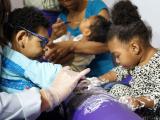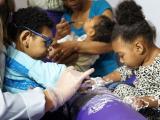As it confirmed local cases in Florida, the Centers for Disease Control and Prevention (CDC) also announced today that Zika transmission rates in Puerto Rico have rapidly increased from February to this month.
"This could lead to hundreds of infants being born with microcephaly or other birth defects in the coming year," said Lyle R. Peterson, MD, MPH, incident manager for CDC’s Zika response and director, division of vector-borne diseases, in a CDC news release. "We must do all we can to protect pregnant women from Zika and to prepare to care for infants born with microcephaly."
More positive tests until mosquito season ends
The CDC released data on Puerto Rico's epidemic today in Morbidity and Mortality Weekly Report. As of Jul 7, 5,582 people, including 672 pregnant women have been diagnosed as having Zika virus infections. Experts say local transmission of the mosquito-borne virus began in December of 2015 and increased this summer. Rates of transmission are expected to continue to rise into the fall and will not subside until winter.
In June, 64% of tests for people with suspected Zika virus were positive, up dramatically from 14% in February. Among symptomatic pregnant women, there was a fivefold increase in positive Zika tests from February to June.
More Zika was also detected during screening at blood banks. In mid-June, the CDC reported that blood screening showed Zika in 1.1% of blood center donations; now that number is up to 1.8%.
1,500 pregnant women might be infected and not know it
The CDC said many of the people who tested positive were symptomatic, and that routine testing of pregnant women was becoming standard during prenatal appointments. Still, the CDC warned that only a fraction of pregnant women who may be infected have been detected, because approximately 80% of people with Zika are asymptomatic and never tested for the disease.
Of the 672 pregnant women currently diagnosed, 441 (66%) experienced symptoms of Zika and 231 (34%) had no symptoms.
Capt. Ken Dominguez, MD, MPH, a medical epidemiologist for the CDC based in Puerto Rico, said the asymptomatic, or "silent," transmission of Zika means that many more pregnant women could be infected.
"We're recommending screening at every prenatal appointment now," Dominguez said in an interview." Some women may initially test negative, then positive later on in the pregnancy." And Dominguez emphasized that contracting Zika at any point in pregnancy, not just the first trimester, could lead to neurologic damage in the developing fetus.
Dominguez said the most worrying figure in today's report is the 5% of asymptomatic pregnant women diagnosed as having Zika virus in June.
"If you extrapolate that 5% to apply to the number of live births that usually occur in Puerto Rico each year [31,000], that's 1,500 pregnant women who could be infected and not know it. That's a large number and quite scary."
The CDC recommends pregnant women in Puerto Rico take action to protect themselves from Zika, including using a condom, wearing long sleeves and pants, and using insect repellent. Dominguez said if women can, it would be best to put off pregnancy until the epidemic subsides in the winter months.
See also:
Jun 29 CDC news release
Jul 29 MMWR report
Jun 17 CIDRAP news story "Blood center testing shows rapid Zika rise in Puerto Rico"





















